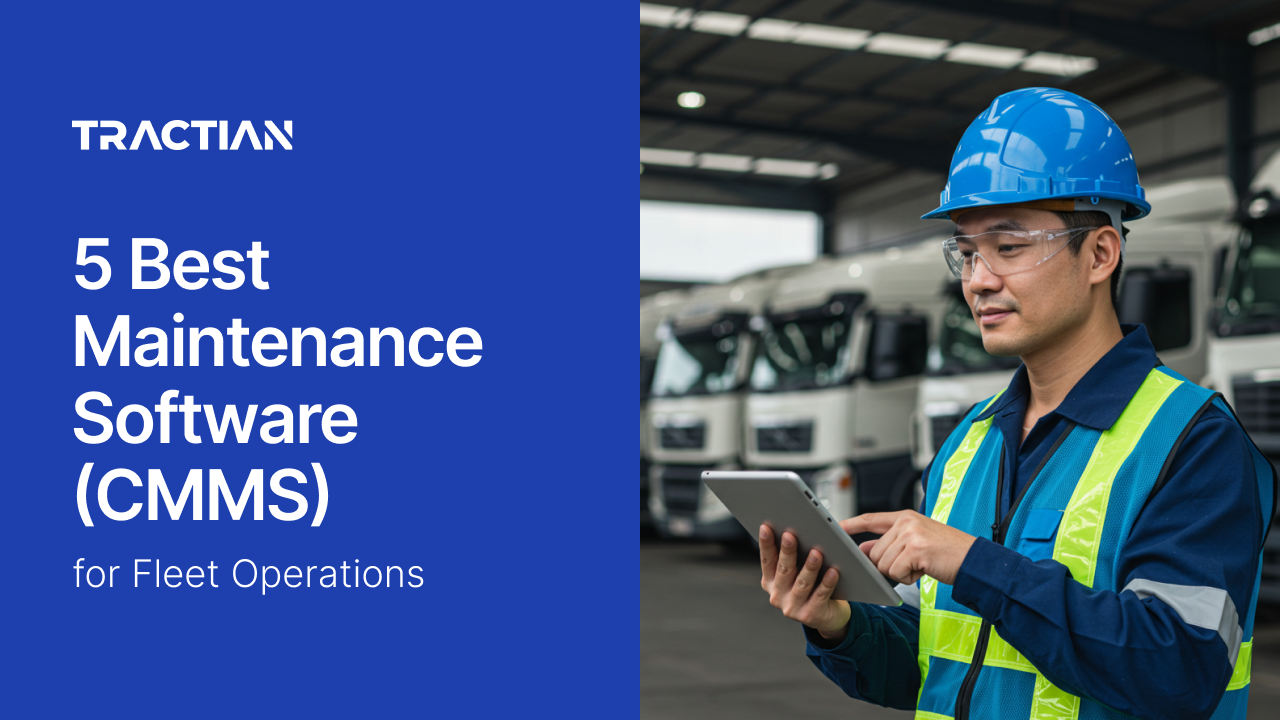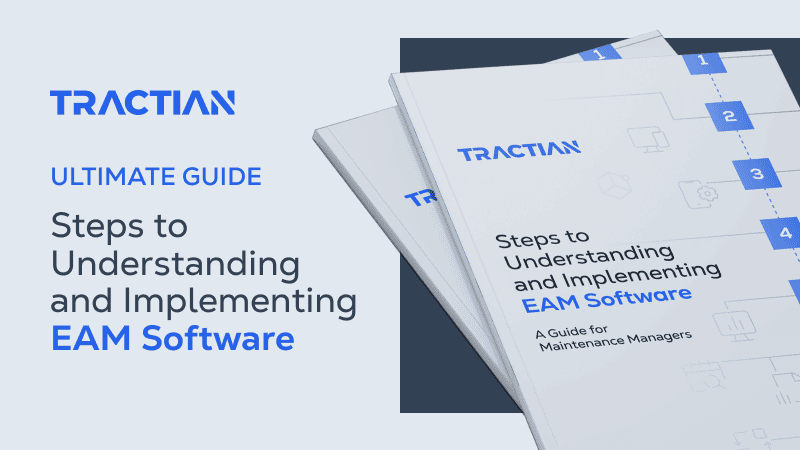If you manage a fleet, you know the numbers don’t lie. When a service truck breaks down or a generator-mounted trailer misses a PM, the whole schedule suffers. Deliveries get delayed, job sites go idle, and field teams lose hours waiting on equipment that should’ve been ready. In fleet operations, unplanned downtime surely slows things down, but its impact is even worse when it comes to lost contracts, labor, and reputation.
That’s why to keep a fleet reliable and ready, you need a CMMS software that can track more than location, being able to monitor asset health, manage inspections, and trigger tasks based on real usage.
A modern fleet maintenance software connects your vehicles, technicians, and data in one place. It centralizes service schedules, digitizes inspections, and links directly to your telematics tools so your team sees every alert, fault code, and overdue PM before it becomes a roadside callout.
In this guide, we’ve broken down the top maintenance software for fleets, from CMMS platforms that manage entire asset bases to dedicated fleet tools built for daily service workflows. Whether you’re running 30 units or 300, these are the systems that keep uptime high and maintenance predictable.
What Fleet Maintenance Teams Actually Need from a CMMS
Fleet maintenance doesn’t live in the office. It happens in garages, on the side of the road, and in staging yards between job sites. And whether you're running a utility fleet, heavy-duty vehicles, or service pickups with mounted equipment, staying ahead of breakdowns is a logistical game of inches.
To do so, you'll need a system that tells you what’s due, what’s urgent, and what’s at risk across your entire mobile asset base.
And when it comes to choosing the best option, these are the features that actually matter:
Preventive Maintenance Based on Time, Miles, or Hours: In fleet, real wear is driven by mileage and engine hours, so your system should trigger service tasks automatically based on odometer data or engine runtime, whether that’s from a GPS system, telematics integration, or manual entry. The goal isn’t just tracking PMs, but making sure they’re done before your team gets sidelined.
Work Order Management That Centralizes Action: No more scattered emails, whiteboards, or texts between drivers and mechanics. Your CMMS or fleet platform should centralize work orders, from creation and approval to parts used and time logged, so nothing falls through the cracks. Whether it’s a routine oil change or an engine fault that needs escalation, the entire lifecycle should be in one place.
Digital Inspection Forms That Replace Paper DVIRs: Paper forms get lost. Photos don’t get uploaded. And manual logs don’t alert anyone. The right system replaces your paper Driver Vehicle Inspection Reports (DVIRs) with mobile-friendly digital checklists, including required fields, photo attachments, and automatic task generation for any failed item.
Offline Mobile App That Actually Works in the Field: Whether it's a remote staging yard, a job site with no Wi-Fi, or a technician out on a service call, connectivity isn't always guaranteed. Your CMMS must support full offline task execution with viewing checklists, logging repairs, attaching photos, and syncing automatically once signal returns. If your techs have to jot things down and enter them later, traceability, accountability, and real-time visibility are already compromised.
Live KPI Tracking That Surfaces Risk in Real Time: When a service interval gets skipped or a fault code isn’t addressed, it's not just a delayed oil change, it’s a potential cascade of breakdowns, lost vehicle availability, and overtime repair costs. Your CMMS should give you real-time metrics on MTTR, PM compliance, technician backlog, and failure rates, broken down by asset, team, or location. That visibility is what helps you catch issues early, rebalance workloads, and keep your fleet on the road instead of in the shop.
Integrations That Centralize the Full Picture: From purchasing systems to ERP software and fuel tracking platforms, your CMMS should act as a central hub. Integrations with Samsara, Geotab, and maintenance vendors let you link data across systems so you don’t have to copy-paste reports or build spreadsheets every time leadership asks what’s going on.

Top 3 CMMS for Fleet Operations
1. Tractian
Best for: Industrial and utility fleets that need usage-based PMs, offline task execution, and real-time risk visibility, all in one place.
Tractian CMMS was designed for maintenance teams that handle both facilities and fleet assets or that need visibility across all of it, without complexity. From preventive scheduling based on mileage or hours to mobile inspections that work offline, everything is built to support fast, accurate execution.
Fleet vehicles can be set up with mileage-based PM triggers, and the system integrates directly with telematics providers to pull data like engine hours, fault codes, or location. That data can then trigger work orders automatically with SOPs, checklists, and parts included. And because it’s mobile-native, technicians can close tasks, upload photos, and flag issues directly from their phones, no Wi-Fi required.
Planners get a drag-and-drop calendar. Supervisors get backlog and KPI views. And leadership gets clean, custom reports on what’s being done, where the risks are, and how downtime is trending, all without building spreadsheets.
What makes it stand out
- Usage-based PMs (miles, hours, cycles)
- Offline mobile app for work order execution and inspections
- Automated alerts based on fault codes or missed PMs
- Telematics-ready: integrates with Samsara, Geotab, etc.
- Combines facility + fleet asset management in one CMMS
What real customers say
- “I like that I can track all of our assets from one location. If a motor is having issues in one part of the plant , and then another on the other side of the plant I am able to basically troubleshoot both motors in one location", says Nicholas D., who works as Maintenance Lead Supervisor in an Enterprise.
- "Tractian's AI eliminates the need for time-consuming program setup and analysis. With the right technical information, I was able to get valuable insights within a few weeks. Tractian is agile with platform and AI updates based on the feedback provided from the end user”, says Jacob H., Reliability Engineer.
Pricing
- Standard Plan: From $60/user/month (minimum 5 users, billed annually)
- Enterprise Plan: From $100/user/month (minimum 10 users)
- Custom Bundles: Available for combining CMMS with Tractian’s condition monitoring sensors
All plans include mobile offline execution, AI-generated SOPs, full onboarding, training, and data migration. A free trial is also available.
2. Fiix (by Rockwell Automation)
Best for: Teams that want a configurable CMMS with ERP integrations and are willing to invest in setup and admin time.
Fiix is a capable CMMS with strong customization options and API access, making it a fit for teams that need workflow flexibility and ERP alignment. For fleet teams, Fiix supports preventive maintenance schedules and work order management across vehicles and other asset types.
It integrates with some telematics platforms, but often requires middleware or custom setup to trigger tasks from live vehicle data. Inspection forms are available, but it's worth noting that SOP enforcement and offline mobile execution require more administrative overhead, which means is more suited for operations that already have internal IT support or can dedicate time to configuration and adoption.
What makes it stand out
- ERP-ready with strong integration potential
- Custom workflows and asset tracking hierarchy
- Multi-asset management beyond just fleet
Limitations
- Telematics integrations not native
- Offline mobile use limited
- SOP enforcement requires setup
What real customers say
- “Not the best for planning and scheduling work orders. Unable to do retroactive corrections. Unable to sort Work orders based on multiple criteria (Ex. can only sort based on Due Date OR Assigned To, not one then the other)”, says Rey G., Facilities Operations Coordinator.”
- “The only recommendations I would make to the program is if it could auto populate the date and technicians name when entering notes and time onto a work order”, says Kyle G., HVAC Technician.
Pricing:
- Standard Plan: From $45/user/month (minimum 5 users, billed annually)
- Professional Plan: From $75/user/month with advanced workflows
- Enterprise Plans: Custom pricing for API integrations and reporting
Implementation support and training sold separately, but a free trial is available.
3. Accruent
Best for: Enterprises with multi-site fleet and facility operations that have dedicated CMMS administrators and IT resources for configuration and training.
Accruent provides a CMMS and EAM platform with work order management, preventive maintenance scheduling, and asset tracking across multiple locations. However, the platform's configuration options and scope can make it difficult to approach without a dedicated administrator, and users report that 40+ hours of training may still leave features uncovered.
It supports preventive maintenance schedules and integrates with ERP systems such as SAP and Oracle via its API. For fleet operations, integrating telematics with GPS providers typically requires third-party middleware or a custom setup rather than native connections. The MC Kinetic mobile app supports offline work orders but requires a separate $58/month subscription per user, which increases the total cost for field-based fleet technicians who need mobile access.
What makes it stand out
- Compliance documentation and audit trails
- ERP integrations with SAP, Oracle, and other systems
- Configurable fields and workflows for mixed asset types
Limitations
- No native telematics support (Samsara, Geotab require middleware)
- Mobile app requires a separate paid subscription
- Interface is dense and may require extended training
Pricing
- Professional Plan: From $110/user/month, includes work order management, preventive maintenance, asset tracking, and inventory.
- Mobile CMMS (MC Kinetic): $58/month per Professional subscription as an add-on for offline mobile access.
- Enterprise Plans: Custom pricing for multi-site configurations and integrations.
Note: Complete pricing requires direct contact with sales. Implementation and training may involve additional fees.
Fleet Maintenance Software Feature Comparison
| Feature | Tractian | Fiix | Accruent |
|---|---|---|---|
| Preventive Maintenance (Time/Mileage/Hours) | ✅ Native usage-based PMs | ✅ Configurable PMs | ✅ Time, meter & condition triggers |
| Work Order Management | ✅ End-to-end with automation | ✅ Full WO lifecycle | ✅ Configurable WO tracking |
| Digital Inspection Forms | ✅ Mobile inspections + SOPs | ✅ Available, not enforced | ⚠️ Available, requires setup |
| Telematics Integration (Samsara, Geotab) | ✅ Integrates with Samsara, Geotab | ⚠️ Requires middleware setup | ⚠️ Requires third-party middleware |
| Alerts & Reminders | ✅ Alerts from PMs & fault codes | ⚠️ Manual alert setup | ⚠️ Rules-based notifications |
| Facility + Fleet Asset Management | ✅ Unified CMMS for all assets | ✅ Multi-asset support | ✅ Multi-site asset management |
Top 2 Dedicated Fleet Maintenance Tools
Fleet-centric operations come with a unique set of demands, especially in industries where compliance, driver safety, and uptime are non-negotiable. That means choosing a dedicated fleet maintenance platform that isn’t just about organizing tasks, but also about building an end-to-end system that connects inspection workflows, telematics data, and maintenance execution with minimal friction.
For many teams, this is translated into investing in tools purpose-built for vehicle oversight rather than trying to force a general CMMS into the fleet mold. These systems focus on what matters most to fleet operators: real-time mileage tracking, automated DVIRs, GPS-linked service triggers, and fault-code-driven workflows.
While platforms like Tractian offer a unified view across facility and fleet assets, there’s still a strong case for tools that specialize exclusively in vehicles, particularly when rapid deployment, driver adoption, and compliance alignment are top priorities.
Here are two of the most established platforms in the dedicated fleet software space.
1. Fleetio
Best for: Operations that rely heavily on vehicle uptime, compliance tracking, and real-time GPS + OBD-II data.
Fleetio is a fleet-first platform that handles service schedules, inspections, fuel logs, driver assignments, and telematics in one interface. It pulls live data from your GPS system or onboard diagnostics to trigger preventive tasks automatically, like oil changes every 5,000 miles or brake checks after 250 hours of engine runtime.
The system supports digital DVIRs, inventory tracking for parts, and vehicle-specific maintenance histories. Its mobile app makes it easy for drivers to complete inspections, flag defects, and upload photos.
It’s not a CMMS, so it won’t handle facility or production assets, but for vehicle-based operations, it’s a good option.
What makes it stand out
- Full lifecycle tracking for fleet vehicles
- Native integrations with Samsara, Geotab, Verizon Connect, and more
- Custom inspection forms and automated PM schedules
- Built-in fuel tracking and driver management tools
Limitations
- No support for facility, shop, or production asset maintenance
- Reporting and dashboarding focused on vehicles only
- Can become less flexible for hybrid fleet + equipment use cases
What real customers say
- “I like how it provides real time tracking and maintenance management, enabling fleets to monitor assets effectively and helpful, providing assistance via email, phone, and online resources", says Ivick J., who works in a Small-Business.
- “My only complaint is that some of the things are not quick and easy to key. Like dates for example, you have to key the entire date including year. It would be great if it defaulted to the current year and you only type the year if it is a previous year", says Summer B., Accounts Payable Specialist in the Mid-Market.
Pricing
- Starter Plan: From $5/vehicle/month (billed annually)
- Pro Plan: From $7/vehicle/month (adds work orders, parts, integrations)
- Advanced Plan: Custom pricing with full API access, automation, and support tiers
A free trial and demo are available.
2. Whip Around
Best for: Fleets focused on inspections, compliance, and DVIR management with integrated GPS and OBD-II data.
Whip Around was designed around vehicle inspections and compliance. It excels in digital DVIRs, checklist-based workflows, and photo documentation of vehicle condition. Tasks are generated based on failed inspection items or fault codes, and the platform supports customizable forms that adapt to different vehicle types.
It integrates with Samsara, Geotab, Motive, and other GPS tools to automate PMs based on real-time odometer or engine data. While it doesn’t offer broad CMMS functions like facility maintenance or multi-asset planning, it’s a strong fit for fleets that need clean, fast inspection-to-repair workflows.
What makes it stand out
- DVIR-first approach with required fields, photos, and defect alerts
- Integrates with major telematics platforms for data-driven PMs
- Fleet-only focus keeps workflows simple and compliance-aligned
Limitations
- No support for non-vehicle assets or facilities
- Not suited for teams managing production lines or hybrid asset bases
- Limited native analytics beyond compliance metrics
What real customers say
- “I enjoy how drivers can complete inspections with ease and it has flexible access for the administration team to view any shipping information that may be needed. The forms are flexible to create to adhere to the needs of your fleet. There is also a proactiveness with maintenance services by creating service schedules that are consistently tracked with the mileage input of driver inspections", says a Verified User in Logistics and Supply Chain.
- “The mechanic section could be a little easier. It has been optimized for shops with in-house fleet maintenance. Something nice to have would be linking with local mechanics", says a Service Manager in Small-Business.
Pricing
- Basic Plan: Starts at $5/vehicle/month
- Pro Plan: $10/vehicle/month with advanced alerts and analytics
- Enterprise Plans: Custom pricing with multi-location, API, and partner support
Free trial and onboarding support are available.
CMMS vs. Fleet Software: What’s the Difference?
At first glance, CMMS and fleet maintenance software might seem interchangeable. Both track preventive tasks, both generate work orders, and both help reduce downtime. But when you look closer, the difference lies in scope and flexibility.
CMMS
A Computerized Maintenance Management System (CMMS) is designed to manage maintenance across a variety of asset types, not just vehicles. From production equipment and HVAC systems to service trucks and generators, a CMMS handles mixed environments where everything needs to be maintained under one roof.
It’s built for task execution, SOP enforcement, scheduling, and real-time visibility across facilities and fleets alike.
Fleet Software
Fleet maintenance software, by contrast, is purpose-built for vehicles. These platforms focus on PMs tied to mileage and hours, DVIR workflows, fault code management, and GPS integration. They’re ideal when your asset base is entirely mobile and when inspections, compliance, and driver behavior tracking take priority over broader maintenance execution.
CMMS vs. Fleet Software Comparison
| Feature | Modern CMMS | Fleet Software |
|---|---|---|
| Asset Types Managed | Fleet + Facilities + Equipment | Vehicles only |
| Preventive Maintenance Logic | Time, usage, cycles (configurable) | Mileage, time, engine hours |
| Inspection Workflows | Digital SOPs, mobile inspections | DVIR checklists |
| Telematics/GPS Integration | Via partner tools (e.g., Samsara) | ✅ Native or pre-integrated |
| Offline Mobile Support | ✅ Full offline execution | ⚠️ Offline varies by tool |
| Cross-Asset Planning | ✅ Unified planning across all assets | ❌ Vehicle-focused only |
| Compliance & SOP Enforcement | ✅ Embedded SOPs & required steps | ⚠️ Basic compliance logging |
| Integration with ERP/SCADA | ✅ ERP, SCADA, Inventory | ⚠️ Light integration |
| Scalability Across Sites | ✅ Multi-site ready | ⚠️ Limited multi-location support |
The Future of Fleet Maintenance
The future of fleet maintenance is no longer about choosing between GPS systems and CMMS, it’s about bringing them together.
Companies are increasingly integrating vehicle tracking systems (like Samsara, Geotab, and Verizon Connect) directly into their maintenance software. That means pulling in live odometer readings, engine hours, fault codes, and asset utilization data to automatically trigger service tasks, inspections, and alerts without manual input.
This trend reflects a broader shift:
- From visibility to action. Knowing where your vehicles are is useful. Knowing what needs fixing and doing it fast is critical.
- From siloed tools to centralized control. Teams don’t want five dashboards. They want one system that connects planning, execution, and reporting across all their assets.
- From fleet-only to mixed-asset strategies. More companies now manage service trucks, trailers, shop equipment, and production gear under one maintenance team-and they need a system that can handle all of it.
Why Tractian Is the Best CMMS for Fleet Maintenance
Tractian CMMS aligns perfectly with this new model. It’s not a telematics platform, it doesn’t replace Samsara or Geotab. Instead, it plugs into them, pulling critical data like mileage, engine hours, and fault codes to automate maintenance in real time.
Where Tractian CMMS sets itself apart is in how it turns data into action. Fault codes generate work orders. PMs are triggered by usage instead of just time. Tasks come with embedded checklists, SOPs, and parts lists, so technicians know what to do, even offline. Supervisors see risk and backlog by asset or route. Planners can balance workload based on site, shift, or technician availability.
And all of that happens in only one interface.
And because Tractian CMMS is so complete, it doesn’t stop at vehicles. You can manage your entire maintenance operation, fleet, facilities, generators, tools, and fixed assets without hopping between systems or losing traceability.
For companies in industrial services, construction, utilities, or energy, where uptime matters more than just GPS pings, Tractian CMMS is the perfect solution.
Want to see it in action?



